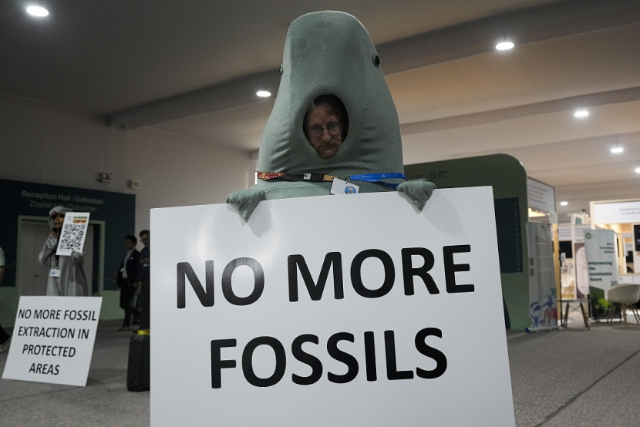
A person in a dugong costume holds a sign that says "no more fossil" at the COP29 UN Climate Summit, on Nov. 19, 2024, in Baku, Azerbaijan. (CFP Photo)
The webinar titled "Southeast Asia's Climate Future in the post-COP29 and Trump 2.0 Era" was held by the ISEAS Yusof Ishak Institute on Dec. 17 in Singapore.
Experts from the U.S., China, and ASEAN discussed the potential impact of U.S. and China policy shifts on global climate actions, the state of climate collaboration and competition between major powers, and the state of climate ambition and perceptions in Southeast Asia.
Hu Bin, Associate Research Professor at the Institute of Climate Change and Sustainable Development at Tsinghua University detailed his interviews with diplomats and climate leaders at COP29 and spoke about deeper cooperation between Southeast Asia and China in renewable energy.
To begin with, according to Prof. Hu, there are limits to sub-national and non-state cooperation without national support between the two countries.
Even if there are actors in the U.S. and China who want to cooperate and engage, there are limitations due to the political climate, which is overshadowed by competition and distrust between the two sides.
"Probably carbon capture, utilization and storage (CCUS), that's the only one technical area that both countries can work together now, because this is also a benefit for the U.S. oil industries," noted Prof. Hu.
Second, given that Trump plans to change the scope of the IRA and also scale back on global solar and wind initiatives to focus on domestic central industries, Prof. Hu claimed that that's the opportunity for China to expand its renewable efforts in Southeast Asian countries.
"China now is the largest single source of international renewable finance for the Southeast Asian regions. Also for electric vehicles (EVs), now Chinese automakers have more than 70% of Southeast Asian EV market," he added.
Finally, Prof. Hu was still cautiously optimistic about the opportunities for the U.S. and China to work together within the Southeast Asian space. Even if both sides cannot cooperate directly, their actions can complement each other.

The aerial photo taken on May 7, 2024, shows a general view of a pepper farm in Cambodia's Kampot province. (CFP Photo)
Ms. Sharon Seah, Senior Fellow and Coordinator of the ASEAN Studies Center and the Climate Change in Southeast Asia Program at the ISEAS–Yusof Ishak Institute, introduced ASEAN's climate trajectory in the context of an impending Trump 2.0 and noted how China is becoming an increasingly important actor in the region's energy transition.
Ms. Seah utilized key findings from the Southeast Asia Climate Outlook 2024 Survey released by the Institute, elaborating on the perceptions of governments and people's attitudes towards climate issues in ASEAN countries.
When asked which ASEAN country has the potential to be the region's climate leader, confidence in Singapore is quite high, having increased from 38.7% last year to 43.1% this year, followed by Indonesia and Thailand.
Additionally, based on the survey, Ms. Seah underscored that ASEAN countries can be categorized into four groups based on their nationally determined contributions (NDC). The grouping shows that most ASEAN countries opted for increasing coverage and sectoral targets rather than economy-wide targets.
Also, Ms. Seah highlighted China as a critical partner to work with on climate issues in the public opinion of ASEAN countries.
The survey showed that China ranks 6th in demonstrated climate leadership in helping the world achieve Paris-aligned goals and 3rd in playing a more proactive role in sharing its climate expertise, practical ability, and technical know-how in ASEAN countries.

Scientific diver Morgan Murphy-Cannella holds bull kelp with a dark patch of reproductive spores as she surveys a reforestation project on Friday, Sept. 29, 2023, near Caspar, Califonia in the United States. (CFP Photo)
Angel Hsu, associate professor of Public Policy and the Environment, Ecology and Energy Program (E3P) at the University of North Carolina at Chapel Hill, highlighted challenges and prospects under a Trump 2.0 presidency.
As for the challenges of the imminent Trump administration on climate policy, Ms. Hsu listed the withdrawal from the United Nations Framework Convention on Climate Change (UNFCCC) and the Paris Agreement as the top issues, followed by regulatory rollbacks. She projected that standards for vehicle emissions, power plants, and appliance efficiency will be challenged in courts.
According to Ms. Hsu, Trump will utilize the courts to sue states that try to take climate action and companies for anti-trust to threaten sub-national action. His usual tactic of imposing tariffs on other countries could continue to raise the cost of clean energy technologies.
Based on Ms. Hsu's forecast, 60% of the funds from the Inflation Reduction Act (IRA), enacted by President Joe Biden in August 2022, will go to projects in Republican districts. One of the act's purposes is to invest in domestic energy production while promoting clean energy.
Reporter: Zhang Ruijun
Editor: Yuan Zixiang, James, Shen He
















